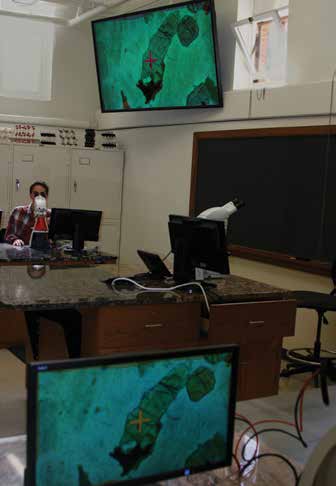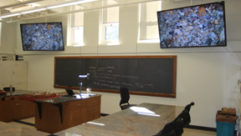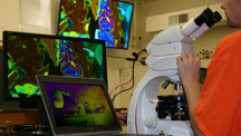

SVC: John and E.J., thanks for joining us from Lafayette College. We’re going to discuss the tremendous technology upgrade that you put in place for your geology laboratory. I know that can be a tedious place if you’re staring into microscopes all day but you came up with a great solution for that. What was the original idea for the lab and how did that evolve as things went on?
John: The original idea for the lab was a standard request to the college for a smart classroom. The room was last updated sometime in the ’70s. It was dark; it was a basement lab. It was dingy; the tables were old and worn down. And there was no technology in there whatsoever: no computer, no projector, nothing. So everything was done the old-fashioned way. Our teaching in the geology department has evolved through the years such that that room did not meet our needs. We wanted to make the lab more technologically advanced.
And E.J., since you didn’t have anything in there, you had nothing to take out. You pretty much had a clean slate I guess.
E.J.: We did end up gutting the room and starting from a blank canvas. But the design for the room was a different approach than what we would typically do for a standard smart classroom. We are lucky that we have the partnership with Vistacom, who has been our integrator for more than a decade now. So we’re able to collaborate with them on the design side. We also had another partner in a local cabinet shop, Jonathan Fallos Cabinetmakers, located here in Easton. With everybody in the room to discuss, the project evolved from a standard classroom idea into the unique laboratory that it ended up being.
How many monitors are there? It looks like you have some pretty big monitors in there.
E.J.: The room is laid out with a large table and in the center there’s an island where the instructor has a space. At the front of the room there are two 80-inch NEC LEDs that are mounted from the ceiling, and then around the room there are also 18 stations for students. Each student station has a microscope and a 20-inch NEC computer monitor that’s connected to that microscope.

Well, that’s fantastic because I know it can be fatiguing to peer into a microscope all day. It’s got to be a lot more comfortable to sit back and watch it on a big monitor.
John: It’s a lot more comfortable, and also it’s a lot more academically engaging. I can walk around the room and see my students and see what they’re looking at on the monitor and interact with them instead of asking them to slide over while I look down the microscope and then push back when it’s their turn again.
What different sources can you display? It’s not just the microscopes. Can you put other things on the monitors?
E.J.: The system is built around Extron XTP Matrix switchers, so everything is really running as an HDMI source; the microscopes and any other device. So we do have the connectivity on the table.
This is an all-Extron system. How do you interface the optics on the microscopes? Do you have something that fits over the eyepiece or is it all electronic inside?
John: Each microscope has a module in between the eyepiece and the body, which is a camera.
E.J.: Because the whole system is interfaced with HDMI connectors on the inside of the table, the students can just as easily plug a laptop into the system. We also have a document camera available in the room and a Blu-ray DVD player. So essentially any HDMI source can be routed through the system on any or all of the monitors.
And how many ins and outs does it have? How big a matrix is it?

E.J.: We’re currently using 22 inputs and 21 outputs on the system.
So you can feed all the monitors and you can feed anything to one monitor. Complete versatility?
John: Complete versatility. We can do one-to-one, one-to-many. I can put any scope on any monitor(s) so students can see anything that works for the class.
Where do you have all of this stored? I’m sure it’s not all just sitting out where anybody can mess around with it. Where is the matrix switcher and its associated equipment mounted?
John: The cabinetmaker that worked with us did a great job in designing the table such that all the electronics, as well as the microscopes and monitors, can be easily stored inside cabinets which are built into the table.
Ah, right. So local cabinetmaker and you were able to work with them pretty much on a custom job.
John: Very custom job. He responded to IT’s thoughts and ideas very rapidly to make a system that worked seamlessly with Vista- com’s setup and our needs.
And you’re using all HDMI? Is that the way the video signals are conveyed to the displays?
E.J.: The displays on the table and everything within the table is essentially just straight HDMI cables. But to get to the instructor’s island in the center, and to the two large displays, we’re converting the HDMI using the Covid fiber cable. So we’re actually running fiber optic cables to those locations.
Well, that is special. I don’t think I’ve heard of a lot of places running fiber optic just inside the room but if you have that many displays and that high-def a signal, that makes sense.
E.J.: It was more a question of the construction of the room. We had to jump through some hoops to get that cable to those displays that are up on the ceiling.
All of that is going to have to work for all of the classes and I know that once classes get in there and it gets to be a busy room, you really don’t have a lot of opportunities for down time or maintenance and upkeep on it.
John: That’s very true. And in order to help facilitate that, Vistacom was very proactive in creating an entire mock-up of our room in their facility where they were able to have a complete setup of the system and test it and verify its work before they ever brought it to the building. When they came and installed it, everything was already proven and working so all they had to do was hook up the wires, run the various cables and press go.
Were there any surprises or anything that didn’t go exactly as planned as far as running cables? Sometimes you run into things behind walls that you didn’t know were there.
E.J.: Well, we were installing this room in the basement of a building that was built in 1899, so no, nothing unexpected there. We had an uneven ceiling to deal with, a concrete floor that had power installed in locations that didn’t work for us. There was some water damage to the exterior walls that had to be remediated. And then the unique piece was the radiators – heating elements – that run along the wall about seven feet or so up from the floor. So we had to tunnel behind them through the brick wall to get those cables up to the displays.
Once this all was in, there was some testing to do and maybe working out a few bugs. How did it go? Did you get some new ideas as you went along? How did it evolve?
E.J.: Well, once we got to the installation point, as John mentioned, because we were able to mock up the system at the Vistacom shop; we went there and sort of did this proof-of-concept. John and I made a couple of changes with the programmer to the touch panel interface at that point, but by the time the gear arrived on campus, it was just a question of installing it in the room and it was up and running in a couple of hours.
It sounds like not only an interesting situation but this is a big job to update a building this old to something this high- tech. This must be great for the students to walk into a classroom like this especially if they had seen it the way it was before.
John: Very true. We did take the old room, which was antiquated, and made it very modern and exciting. Because it was a clean slate, the nice thing about the room is that we were able to bring in aspects that make the geology department tick. So instead of having boring black lab tables, we have 12 slabs of different types of rocks for the tabletops. So when the students walk in, the first thing they’re awed by is just the beauty of the classroom. And then when we bring out the technology, it really shows them what the room can do.
Why did you decide to use the Extron TLP Pro touch panel?

E.J.: It’s actually a 10-inch Extron touch panel. We started in 2011 on a classroom upgrade project to retrofit all our existing smart classrooms. And part of that strategic plan was to switch over to the Extron control systems. So we’re in the process, we’re about 60 percent complete now in that process and we’re converting all our systems over to Extron control.
I know one of the more challenging things in the higher-ed world for tech people is to keep up with the concept of “bring your own device.” That’s what everybody wants to do but it can bet ricky to accommodate anything that comes in. How BYOD- friendly is this room and what types of devices do the students bring in?
John: The room is very BYOD-friendly, but it’s really broken down into two components. There’s the system BYOD and then there’s the microscope BYOD. So because the system is set up with HDMI ports, we can plug in just about anything with an HDMI out into the system, which is really nice if students want to plug in their laptops to be able to show what they’ve done, show their project, present a presentation. On the other side with the microscopes, all the cameras are Wi-Fi enabled so we’re making a bunch of little wireless access points in the room where their laptops or their smart phones can connect via an app to the microscope and record live video, take digital still images, annotate the images, and record information of what it is they’re actually studying on the scope at that time. It’s been very productive for the students to be able to interface with whatever device they want to.
All right. So you don’t have a big mass of cables going everywhere and people trying to plug into the right place. Was any sort of RF coordination necessary to allow all of these wireless connections?
E.J.: No, we haven’t had any problems with the wireless, you might be surprised, because we’re essentially running 18 ad hoc wireless networks off of those microscopes and then there’s also the college wireless in the room as well. But so far, knock on granite, we haven’t had any issues.
You mentioned how old this room is. Were any electrical upgrades necessary for the room to have this many sources and displays? Did you have to add a lot of AC outlets?
E.J.: Well, there was power in the concrete floor but unfortunately it wasn’t in the place that we needed it to be for this new furniture layout. So again, we have a great relationship with our facilities department here at the college and they brought in their folks and they were able to move the electricity and add what was needed. We did have to run some extra data cables into the room to accommodate some of the systems, but nothing extraordinary.
Well, it’s always great when you can get that much done in-house. That varies widely between institutions. How was the wiring done when it got to the furniture? Did you have to work with the cabinet maker in drilling holes and installing mounts?

John: All of that work was initially designed with the cabinet maker and Vistacom as we went through the process, such that the cabinet tops were pre-cubbied out. There were sets for high-voltage lines and a second cubby for the low-voltage HDMI lines. They’re isolated from each other and everything was set to the distances of where we wanted all the boxes to go. The cabinetmaker put all those things in exactly where they needed to be such that when the cabinets were in place, the electricians came in and they were able to run that wire because they knew exactly where it was going to go.
You guys thought of everything, and when you got this all up and running there’s a point where you unleash the students and faculty on this and stand back and see if there’s anything that you need to tweak. How was the response from the users on the new system?
E.J.: So it was pretty funny. We were install- ing this room, as John mentioned, over the week before the semester started, so people are back on campus and there’s lots of buzz going around. And this was very well-choreographed. We had the cabinet bases come in, we had the electrician come in, we had Vistacom come in, and we had the granite tops laid down. And as this process is going on over the span of that week, we have the faculty who are sticking their head in the room because they want to see what’s going on in here. So it was pretty interesting and the excitement level was pretty high before we actually let the folks into the room. As far as the learning curve piece of it, we learned a long time ago here that you want to keep a standard user interface on your touch panels. And so we’ve stuck to that throughout the last 15 years that we’ve been using touch panels. So from a user standpoint, the layout to the touch panel is very similar to any other room that they may have used on campus.
John: The only difference to the touch panel is there’s an additional programmed screen for the scope matrix. It’s set up such that we can turn Microscope 1 onto Monitor A, and Microscope 2 onto Monitor B, and anything in between. That was the only new programming or the new touch panel interface that we actually had to learn, which really wasn’t that hard to learn because once you see the touch panel’s display, it’s arranged in the shape of the room. So if you see the student in that corner of the room, you can instantly know which microscope they’re on and everything just follows suit from there.
E.J.: And that’s the beauty of the Extron touch panel systems—we’re able to easily create those graphical representations of the room layout and make it very intuitive. And we never could have done this with a button system.
And the bottom line is that this is all about the students. Did they hit the ground running and can they now pretty much forget about the technology and just learn?
John: Absolutely. The students have embraced the room. Students that have learned in that room previously, who have taken classes in that room previously, come into the room now and they see the change from what it’s been. Students that have never learned in that room before come into the room and it’s a brand new space for them with no preconceived notions of what’s going to happen. And so they’re excited to learn in that room. But what’s great is that the technology is not only enhancing the way the students learn, but it’s enhancing the way we teach. We’ve already found a couple of different ways to utilize the system that we didn’t even think about when we were in the design stage. For example, when students were taking an exam last week, typically we have students looking through the microscope for part of the exam. Instead of having 18 microscopes around the room and every student having to look through the microscope, we had two stations and each station was ported up to the large monitors. That way, if a student who is very comfortable with using the microscope didn’t want to go and sit at the microscope, they could watch what’s on the monitor from another student using the microscope, and answer the questions to the exam without actually having to go and utilize the microscope. So we’re teaching differently. We’re teaching more effectively. Students are learning newer ways to look at things, and in general it’s saving time on both ends. For us to teach, it’s more time effective. And for students to learn, they’re grasping concepts much more quickly. We’re excited to see where the next 30 years of the room takes us.











